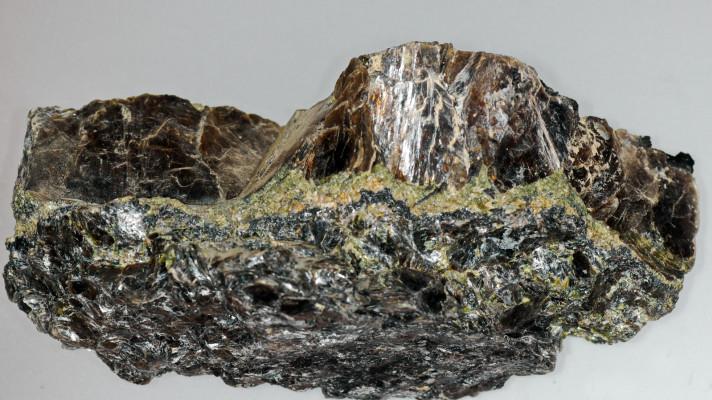Geologický vývoj egejského prostoru (The geology of the Aegean)
It offers in a unique way the possibility to study the interrelation between the evolution of an Alpine orogenic belt and the development of a marginal basin in it. The intimate relation of young continental orogenies and marginal basins seems to be a general rule. Gravity instability caused by nonhydrostatic forces in a laterally nonhomogeneous crust is regarded as the initiator of disintegration in the marginal basin. Upwelling mantle material caused by lithospere subduction reinforces the back arc expansion. This is shown by model experiment.
INTRODUCTION
The Aegean region is a small but geodynamic ally extremely active part of the Alpine - Himalayan orogenic system. Its seismicity is the highest in the European - Mediterranean region. Seen from the perspective of a satellite it seems that the mountain chains of the Dinarides - Hellenides are spreading apart and submerging in the floods of the Aegean Sea before reappearing in the Tauridic mountain belt of Anatolia. The traces of the foundered land masses are marked by islands, scattered or grouped into chains. This rather superficial picture already contains quite correctly some essential features of the geologic history of the Aegean World.
In this paper an attempt is made to summarize and evaluate our present knowledge of geological and geophysical information with the aim of a better understanding of the processes which have finally led to the present situation.
Fortunately, in recent years, stimulated by the International Geodynamics Project, comprehensive systematic research has been carried out in many fields of geosciences in this area.
Physiographically the Aegean Sea is a marginal basin bordering or even penetrating the European continent, and bounded toward the eastern Mediterranean Sea by the Hellenic Island Arc. A first question arises: Is this structural similarity to Pacific, Indonesian, or Caribbean island arc systems only superficial, or are these processes of essentially the same kind? There exists a broad spectrum of widely differing opinions. A systematic comparison may help us to find the answer.
The most comprehensively investigated part of the Hellenic Arc is the Peloponnesos region, which may, therefore, serve as an example of the arc structure.
Taking into account recent results from marine geophysics (Weigel 1974, Finetti 1976, Jongsma et al. 1977), neotectonics (Kelletat et al. 1976), precision hypocenter determinations and focal mechanism studies of earthquakes (Leydecker et al. 1977, Ritsema 1974), explosion deep seismic sounding (Makris 1977), and gravity field survey (Makris et al. 1973) it may be justifiable to draw a generalized West - East cross-section through the Ionian Sea, Hellenic Trench, Peloponnesos into the Aegean Sea as shown in Figure 1 (Berckhemer & Kovalczyk 1977).
Thick lines indicate seismic refractors or reflectors, chiefly crust-mantle boundaries. Low angle underthrusting of the Ionian crust below the Peloponnesos and / or equivalent thrusting of the Peloponnesos over the Ionian crust is evidenced by a gently dipping refractor, the seismic stress field, a thrust fan of sediments in the trench region, and the upward bending and exposure of the lower Hellenic nappes near the Ionian coast. The antithetic block rotation within the body of the Peloponnesos might be the consequence of under-thrusting in the West.
Toward the Aegean Sea the tectonic style changes into predominantly normal faulting with extension of the crust. A "Benioff Zone" of earthquake hypocenters, branching off where the crust reaches its greatest thickness and dipping down under 40o toward the central Aegean to a depth of 160 -180 km, is clearly visible. The tension axes of some intermediate deep shocks point along the dip of the Benioff Zone indicating, in terms of plate tectonics, a lithospheric slab pulling downward under its own weight. Where the foci reach a depth of 100 - 150 km Quarternary andesitic volcanism occurs at the surface. The K2O/SiO2 - ratio of these volcanic rocks compares well with those from other island arc regions where a Benioff Zone lies at a depth of 120 - 150 km (Ninkovich & Hays 1973). Although one has to be careful in generalizing over the situation of the Peloponnesos, the following features, typical for marginal sea-island arc structures, are found in the Aegean region: a deep sea trench with a pronounced negative free air gravity anomaly af - 130 to - 250 mgal (e. g. Fleischer 1964); a non-volcanic frontal arc (Hellenic Island Arc) stretching from Kephalinia via Peloponnesos, Crete, to Rhodes; high seismicity with foci in normal and intermediate depth; a Benioff Zone of amphitheatrical shape, dipping down toward the central Aegean, is at least indicated in a general sense (Papazachos & Comninakis, this volume); an inner island arc with Quarternary andesitic volcanism (Aegina, Methana, Milos, Santorini, Nisyros, Antiparos, Kos) above hypocenters in 100 - 150 km depth at a distance of about 200 km from the trench; tensional tectonics in the back-arc region (see Figure 2); high heat flow up to 2.7 HFU in the central Aegean Sea, (Jongsma 1974) and low heatflow in front of the arc; high absorption of seismic waves in the upper mantle behind the island arc (Papazachos & Comninakis 1971).
More on:http://www.therafoundation.org/articles/geology/thegeologicalevolutionoftheaegeanregion
ZDROJ: www.therafoundation.org
